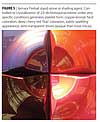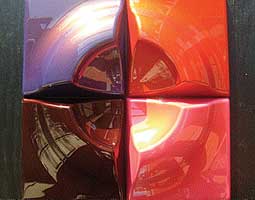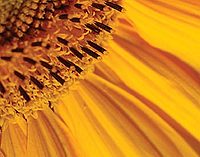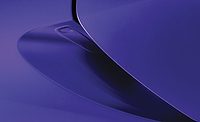Unlike multilayer effect pigments, organic platelets cannot produce multicolor interference effects, but instead two colors, the one observed in remission and the other in transmission. To obtain good results, it is important to ensure that both coloristic phenomena (remission and transmission) are well balanced for an ideal overall color effect. To allow the creation of this ideal interference effect, the crystals must have a specific depth, width and length. Surprisingly, numerous organic pigments are able to generate such effects; the bluish flop usually observed with quinacridone pigments can be considerably extended, and exotic combinations with dioxazine pigments switch color from green to violet.
Introduction
Organic pigments have been well established in the coatings industry for many decades. They are well known for their high color strength and transparency, as well as for their chromatic effects. A wide range of chromophores have been available, and all kinds of imaginable shades are offered by pigment and coating manufacturers. New and unique colorations are becoming more and more difficult to achieve. Over the past few years the industry focus was mainly on new formulation technologies, niche products or a few distinct compounds. The impact of the latter is rather limited in comparison with the success of the last major chomophore discovery, diketo-pyrrolo-pyrrole pigments (DPP), in the late 1980s. Finally, there is a wide range of organic colorants available for coatings, so almost all color innovations are linked to inorganic systems, i.e., multilayer effect pigments or highly reflective aluminum flakes.Thanks to experience acquired in both these domains – classic organic substances and inorganic effect pigments – new stylings can be created today by raising organic pigments to the level of effect pigments. The new effects are created by compounds that are manufactured in the form of “organic platelets.” The intrinsic color of these materials is still closely linked to their chemical structure and the alignment of the molecules in the crystal lattice. However, the specific shape of the particles allows new phenomena to appear, caused by the combined effect of light reflection, transmission and scattering. The new deep color effect produces subtle reflections with a hue-shifting color travel.
Automotive coatings are the ideal market for this new generation of organic interference pigments. For example, the metallic shades can be attractive and eye-catching, but the impression of depth is increased thanks to the high chromaticity and shade of the organic platelet. Thus, the final coating can appear much thicker than it actually is.
Results

|
| Figure 1 Click to enlarge |
Xymara™ Fireball™ is a new organic effect pigment for exterior automotive coating and other high-performance applications, including consumer goods such as mobile phones and electronic devices. The new effect pigment is based on 2,9-dichloroquinacridone (Figure 1), which has been known and used for many decades in coating applications.
The shade areas covered by this pigment are very popular, and products derived from it are widely appreciated for their high value in use. All properties linked to the already commercialized pigments – weather fastness, gloss and stability – remain unchanged when the pigment is modified to produce the platelet structure.

|
| Figure 2 Click to enlarge |
The quinacridone class was primarily selected because the various commercialized products develop a variety of colors and effects, which are dependent on crystal size and crystal shape (Figure 2). Thus, the transformation of a quinacridone into an organic effect pigment is inherent.
In its original needle-shaped morphology (>200 nm), red/violet shades with strong hiding power can be obtained. At an average size of about 200 nm, color strength increases and the hue becomes magenta. Finally, at a particle size of around 50 nm, the transparent orange crystals develop a bluish flop, which is very popular in automotive coatings. Throughout these smooth changes from red to magenta to orange, color strength always remains very high, which is a significant advantage of this chromophore over other red pigments.
The effects attainable with 2,9-dichloroquinacridone are summarized in Figure 2. As already mentioned, three different colors can be obtained with the same initial chromophore. Combining all these properties in crystal form becomes a worthwhile way of obtaining novel color effects with existing chemistries.
Additionally, since all the changes happen in the same color space (reddish area), visual appeal is not impaired by abrupt color jumps as is often the case with the rainbow effects of some well-known inorganic multilayer effect pigments.

|
| Figure 3 Click to enlarge |
Thanks to an innovative finishing process based on crystal manipulation, the respective product is grown in platelet form and becomes an interference pigment with the expected differences in transmission and remission color (Figure 3).
With this platelet form and by varying the viewing angle, the color observed in remission is progressively replaced by the one seen in transmission. As shown in Figure 4, for the same ‘a’ value (a = 40) two distinct colors can be observed, depending on the orientation (b = 28 and b = 48). Such phenomena have never been observed with traditional trade forms of quinacridone pigments already on the market.

|
| Figure 4 Click to enlarge |
Applied as a stand-alone pigment in coating applications, quinacridone platelets offer a color range that varies from orange/gold to a deep cherry red, as the angle of observation changes (Figure 5). With its thin, flake-like particles (Figure 3), Xymara Fireball adds a discreet sparkle when used in an effect color formulation. Inherent transparency makes it suitable for use in combination with different chromatic transparent pigments as well as in multilayer paint systems, giving new, unusual effect shades with exceptional depth. The multilayer effect is also achieved by applying the new pigment to transparent plastic parts either by coating onto the surface or by mass coloration.

|
| Figure 5 Click to enlarge |
A number of other red compounds give similar effects in coatings or plastics. Perylene pigments allow marked color-travel effects from red to blue, but they are less suitable for coatings because of the irregular flop and sudden drop in strength at certain angles. DPPs are attractive as organic effect pigments due to the sparkle they develop in platelet form.
Another pigment class delivering unusual effects is dioxazine. These conventional crystal forms were commercialized in the middle of last century, and remarkable effects could be created with the two main representatives, C.I. Pigment Violet 23 and C.I. Pigment Violet 37, merely by specific modification of crystal size and shape (Figure 6).

|
| Figure 6 Clck to enlarge |
In platelet or rod-like form, dioxazines appear violet in transmission, but in remission a variety of different green, brown, red or blue colors can be created despite identical chemistry. Their abrupt jump from one color to another makes dioxazines more attractive for ink and plastic colorations than for automotive stylings. Therefore these fancy effects tend to be used for the design of smaller consumer goods such as toys or mobile phones. In these applications, where radical color changes (e.g., from green to violet) take place, attention is captured, curiosity aroused, and the coated object becomes the center of interest.
Summary

|
| Figure 7 Click to enlarge |
In summary, it has been demonstrated that it is still possible to generate innovative color effects for coating, plastic and ink applications using existing, established organic pigment chromophores. Through novel processes requiring crystal manipulation, natural shades are revealed with sparkle and hue-shifting characteristics.
Acknowledgments
The authors would like to thank all team members for their contribution in this project, especially V. Herle and P. Brown.
This article is based on the presentation “Deep color-travel effects with organic effect platelets,” given by Marc Maurer at the European Coatings Congress on April 1, 2009 in Nuremberg, Germany.




Report Abusive Comment